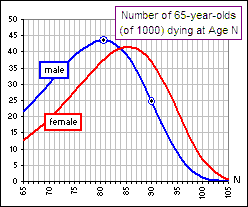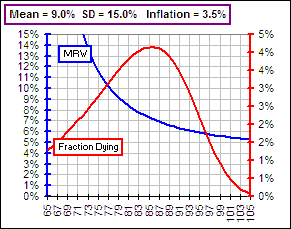| Withdrawals ... and Life Expectancy |
The other evening I was watching a bad TV movie and started thinking ...
>Now that was a mistake!
... about Safe Withdrawal Rates and the
notorious 4% rule and ...
>Not again! You've done that,
here and
here and ...
Yeah, but here's what I was thinking. You can withdraw 100% per year, from your retirement portfolio, and have
it last until you die. Did you know that?
>Sure, if you drop dead very soon.
Exactly! Remember that stuff we did about Life Expectancy?
Well, suppose we mix that stuff with the other stuff and ...
>And just add water and a pinch of salt.
Pay attention. Here we go:
- We begin our retirement with a portfolio worth $P and we withdraw $A every year.
- The withdrawal amount increases at the Inflation Rate which we assume is I (for 3% inflation, I = 0.03).
- Our annualized Portolio Return is R (for 9% return, R = 0.09).
>I hope you're not talking constant Inflation and Return?
Yes, for the time being. Let's continue:
- If we withdraw for just N years, the Maximum Rate of Withdrawal,
that's MRW = A/ P,
is given by the magic formula we obtained
here:
MRW = 1 / (x + x2 + x3 + ... + xN) where x = (1+I)/(1+R) - There's a formula for that sum; it can be rewritten:
MRW = (1/x) (1 - x) / (1 - xN)
|
>Wait! What's that chart saying? I can't ...
>Yeah, yeah, I can see that, but it says that only about 44 will die by age 81. Are you kidding?
>And if I add all those numbers I'd get 1000.
|  Figure 1 |
|
Okay, so we superimpose the Number Dying and the MRW-rates versus
N ... or, for a 65-year-old, your age, as in Figure 2.
>You're assuming some return on your portfolio, eh?
>Looks like that MRW is approaching ... looks like 5%.
>That 4.3% looks like the notorious safe withdrawal rate!
>That's for a male, eh? What about females or bigger inflation or ...? |  Figure 2 |
When one uses Monte Carlo simulation one likes to say
things like:
"With a 99% probability such and such will happen."
We'll do the same here. We'll say:
"With a 99% probability, your portfolio will survive you, if you withdraw at such and such a rate."
Here's a picture of a spreadsheet which does this:
To play with this online spreadsheet, click on the picture above.
>But it's still got those constant Mean and Standard Deviation.
Yes ... so far. But I should point out that the portfolio gains are the Annualized return, not the Mean.
To get this we use the approximation noted
here, namely:
Annual Return = SQRT[ (1+Mean)2 - SD2 ] - 1
How good is this approximation? Check this online spreadsheet: click!
>And what about random returns and ...
Check this online spreadsheet: click!


